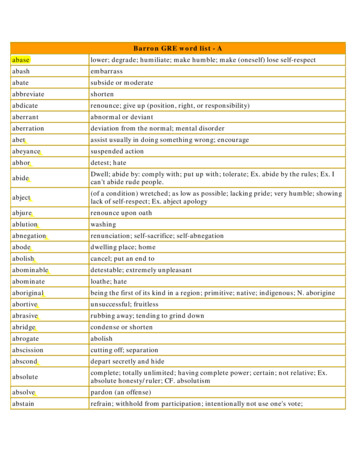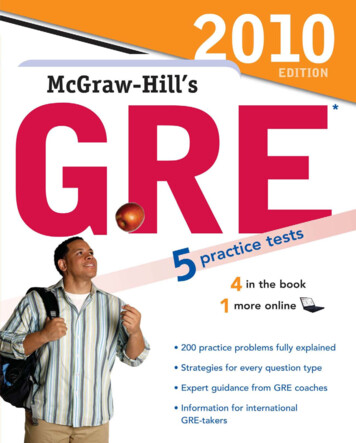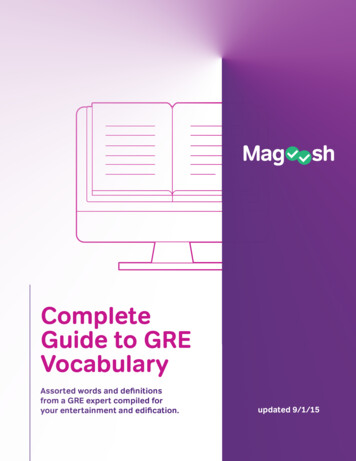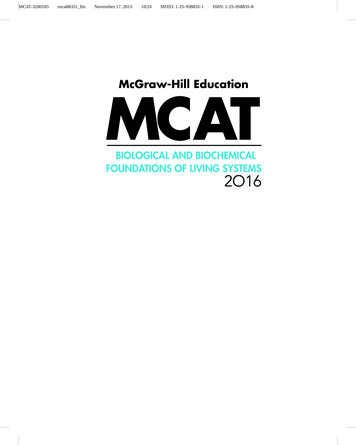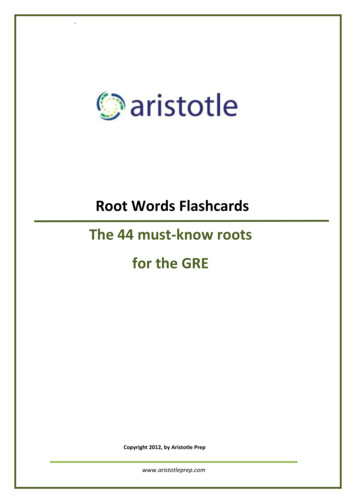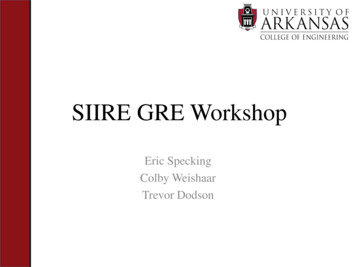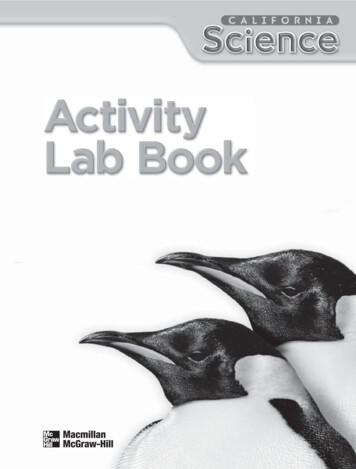
Transcription
W E LCO M E T OMcGraw-Hill EducationGRE PremiumYou’ve made the right decision to study for the GRE using this guide fromMcGraw-Hill Education, America’s leading educational publisher. Youmay know us from many of the textbooks you used in college. Now we’reready to help you take the next step—and get into the graduate schoolprogram of your choice.This book gives you everything you need to succeed on the test. From expertauthor Erfun Geula, you’ll receive in-depth instruction and review of every topictested, tips and strategies for every question type, and plenty of practice tests toboost your test-taking confidence.In addition, in the following pages you’ll find special sections on: Getting the Most from the Interactive Practice Tests: Download thePremium Practice Test App to your tablet or smartphone or visit thecompanion website for extensive test-taking practice. Information for International Test-Takers: Find out what you need to knowif you plan to take the test outside of the United States.ABOUT McGRAW-HILL EDUCATIONThis book has been created by a unit of McGraw-Hill Education. McGraw-HillEducation is a leading global provider of instructional, assessment, andreference materials in both print and digital form. McGraw-Hill Education hasoffices in 33 countries and publishes in more than 65 languages. With a broadrange of products and services—from traditional textbooks to the latestin online and multimedia learning—we engage, stimulate, and empowerstudents and professionals of all ages, helping them meet the increasingchallenges of the 21st-century knowledge economy.1A
Getting the Most from the Interactive Practice TestsMcGraw-Hill Education: GRE Premium gives you a number of options to practicefor the exam. You can practice using this book, your tablet or smartphone, or yourlaptop or home computer. Whether you use a PC or Mac or a tablet or smartphonewith the Apple, Android, or Windows platform, you’ll be able to practice on thedevice of your choosing.The diagnostic test in this book is also available in a digital version as part of thePremium Practice Test App and on the companion website, MHE Practice Plus.In addition to the diagnostic test, you will find five more practice tests on the appand companion website.Features of the Interactive Practice TestsThe interactive practice tests found on the mobile app and the companion websiteoffer a number of features that will help you meet your study goals: The app and the companion website include the diagnostic test from thebook, allowing you to take advantage of the digital version of this test. The app and website include five additional practice tests that will enhanceyour preparation for the exam. You can choose whether to take a test section timed or open-ended,depending on your practice goals. When you finish a section of the test, you’ll immediately receive a score thatshows the percentage of correct answers. Your scores will be saved so you can refer back to them and follow yourprogress. Review mode allows you to see your answer and the correct answer together.(We hope they’re the same!) Here you’ll find a concise and clear explanationfor the answer. Moreover, you’ll still be able to see the original question forreference. If you exit a test section before finishing it you can simply return to whereyou left off at a later time.Accessing the Premium Practice Test AppIf you take the diagnostic test and six additional practice tests on your tabletor smartphone, you will find the Premium Practice Test App to be the idealcompanion to your study plans. Depending on the device you have, go to oneof the following:Apple iTunesAndroid Google PlayWindows Apps for WindowsOnce you’re at the appropriate app store, search “McGraw-Hill Education’s GREPremium Practice Test App” and download.2A
Accessing the Practice Tests OnlineVisit MHPracticePlus.com/GRE to access the online version of the practice tests.Click on “begin practice tests” and you’ll have access to the diagnostic test and sixadditional practice tests to use on your laptop or home computer.Information for International Test-TakersEvery year, more and more international students take the GRE General Test.Of the more than 655,000 tests administered in 2012, the biggest growth amongtest-takers during the peak testing period was among international students. Ifyou are an international student who is planning to take the GRE in order topursue graduate or business school studies in the United States, these pages willprovide some information that can help make the process easier for you. We alsosuggest that you visit the official GRE website, www.ets.org/gre, for further detailsand updates. The site is maintained by Educational Testing Service (ETS), theorganization that creates and administers the test.The GRE General Test is currently offered as a computer-based test in theUnited States, Canada, and many other countries. The test is offered in a paperbased format in areas of the world where computer-based testing is not available.Arranging to Take the GREFinding a Testing CenterWith permanent testing centers located in countries all around the world, mostapplicants should not have trouble finding a place to take the test. If there are nocenters near your home, you will need to travel to one. When you register for theGRE, you will need to schedule a test appointment at a specific testing center.Go to www.ets.org/gre for a complete listing of testing centers worldwide.Registering for the TestRegister early to get your preferred test date and to receive your test preparationmaterial in time to prepare for the test. Remember that testing appointments arescheduled on a first-come, first-served basis. There are four ways you can registerfor the computer-based General Test: on the Internet, by phone, by fax, and bymail. Major credit cards are accepted to pay for registration. To register visitwww.ets.org/gre.Standby TestingStandby testing is available at permanent test centers on a first-come, first-served,space-available basis in the United States, American Samoa, Guam, U.S. VirginIslands, Puerto Rico, and Canada only. It is not available in Mainland China,Hong Kong, India, Iran, Korea, or Taiwan.3A
Canceling or ReschedulingIf you must cancel or reschedule a testing appointment, contact the GRE Programby mail or phone no later than four full days before your appointment (notincluding the day of your test or the day of your request). Keep in mind that youcannot reschedule between sites served by different Regional Registration Centers.See the ETS website for details.Paper-Based TestingYou can register for the paper-based General Test either online or by mail. Use amoney order or a certified check when registering by mail. Download and completethe registration form and mail the completed form with payment to the addressprinted on the form. ETS must receive your registration form by the registrationdeadline, which can be found at www.ets.org/gre. Allow at least four weeks forprocessing.IdentificationIt is your responsibility to bring an acceptable form of identification to the testingcenter. The following documents can be used in the country in which you area citizen: PassportNational ID cardState or Province ID cardOfficial driver’s licenseMilitary ID cardSee the ETS website for further details.Test Preparation for International StudentsETS is very careful to make sure that the GRE is not biased against internationaltest-takers. All questions are pre-tested by being included in unscored“experimental” test sections given to both U.S. and international test-takers. Ifstatistics prove that any of the new questions put the international test-takers at adisadvantage, those items never appear on the test. Still, international test-takersface certain challenges.The Language BarrierThe biggest and most obvious difficulty for international test-takers is the languagebarrier. Many people residing outside of the United States who sign up to take theGRE are non-native English speakers. The entire test, including instructions andquestions, is in English. One part of the test is focused on verbal skills and anotherpart is a writing test, which requires not only an understanding of the languagebut a command of it. Your English writing, reading comprehension, and grammarskills are directly tested on the GRE. If you are a non-native English speaker, toimprove your understanding of the language in the months leading up to the test,you are encouraged to:4A
Read as much in English as possible, especially newspapers or journal articles Create flash cards with difficult English words on them Practice your English by speaking with others who speak the language—preferably better than you do! Watch television shows featuring native English speakersYour goal should be to practice presenting evidence in a cohesive and interestingway to support your arguments in the writing section of the exam. When youread items from English-language publications, pay particular attention to howthe writers gather evidence and present it because there are often subtle culturaldifferences at play. Remember that the quantitative part of the GRE is also inEnglish so it’s a good idea to review math formulas and glossaries in English.Becoming Familiar with Standardized TestsGetting acquainted with standardized tests is another must-do for internationaltest-takers. This type of exam is a part of the average American’s educationalexperience but is not necessarily a cultural norm in other parts of the world.Some people outside the United States may be unfamiliar with multiple-choicequestions. These are questions in which you are given several choices from whichto choose for the correct answer. There are strategies for choosing the best onewhen you’re not sure. For example, you can eliminate answers that you know areincorrect and then choose among the remaining choices. This is called “taking aneducated guess,” and it can improve your chances of picking the correct answer.Timing is a very important part of standardized tests. Keeping calm is the first stepto overcoming the pressure. Taking practice tests is key to learning how to paceyourself to maximize your performance in a limited time period. Taking practicetests will also help you become familiar with the test format. Understanding theinstructions for each part of the test in advance can save you time during the exambecause you won’t have to spend time on the instructions in addition to the otherreading you have to do.Testing Your English-Language SkillsIf you received your undergraduate degree from an institutionin a country whose official language is not English, the graduateprogram to which you are applying will likely require youto submit proof of your English proficiency along with yourGRE scores. Most institutions accept scores on either theTOEFL (Test of English as a Foreign Language) or the IELTS(International English Language Testing System); many nowalso accept scores on the newer PTE (Pearson Test of English).Check with the programs to which you are applying for information about theirtest requirements. There is no specific passing score on these tests; graduateinstitutions set their own requirements. TOEFL: The TOEFL iBT is an Internet-based test administered more than50 dates a year at more than 4,500 sites around the world. A paper-basedversion (TOEFL PBT) is still used but only in a few locations where Internetaccess is not reliable. For more information including the format of the test,5A
scoring, and registration, visit www.ets.org/toefl. The TOEFL iBT capturesthe test-taker’s speech and uses this to measure English-speaking ability in astandardized manner. Multiple-choice questions are used to measure readingand listening abilities. Two essay questions are used to measure writingabilities. IELTS: The IELTS is a paper-based test created at Cambridge Universityin the UK. It consists of four modules—Listening, Reading, Writing, andSpeaking. Question types include multiple choice, sentence completion, shortanswer, classification, matching, labeling, and diagram/chart interpretation.The Speaking test is a face-to-face interview with a certified examiner. IELTShas two versions: Academic and General Training. The Academic test is forthose who want to study at a tertiary level in an English-speaking country.The General Training test is for those who want to do work experience ortraining programs, enroll in secondary school, or migrate to an Englishspeaking country. For more information, visit www.ielts.org. PTE: The PTE was developed by Pearson, an international educational testingand publishing company. Like the TOEFL iBT, it is administered at testingcenters on a computer (there is no paper version). Visit www.pearsonpte.comfor more information about the PTE and updated lists of the schools thataccept it and the locations where it is given. Like the TOEFL, the PTE usesmultiple-choice questions plus essay questions to measure reading, listening,and writing skills. A 30-second audio clip of the test-taker’s speech is sent toschools along with the test scores.One Last Hurdle: The Student VisaNonresidents of the United States need to obtain a visa to live in the United States.Once you have chosen a graduate program and have been accepted, you will needto begin the process of obtaining your student visa.Getting a student visa to study in the United States is not as difficult as gettingan H1-B visa to work in the country after graduation. Experts, including theU.S. government, suggest that students begin the student visa process as early aspossible. Besides needing the time to complete the required forms, you will alsoneed to schedule an appointment for the required embassy consular interview, andthe waiting times for this vary and can be lengthy.Visa RequirementsDuring the student visa process, you are expected to prove that you have adequatefinancing to study in the United States, ties to your home country, and a likelihoodthat you will return home after finishing your studies. In addition, you will have toparticipate in an ink-free, digital fingerprint scan and provide a passport valid fortravel to the United States and with a validity date at least six months beyond yourintended period of stay.Your U.S. school will provide you with an I-20 form to complete. The school willuse this to register you with the Student and Exchange Visitor Information System(SEVIS), an Internet-based system that maintains accurate and current informationon nonimmigrant students and exchange visitors and their families. If you havea spouse and/or children who will be joining you, you must register them with6A
SEVIS as well. You’ll also need to submit a completed and signed nonimmigrantvisa application with form DE-160. To download this form and for moreinformation on the visa process, go to the U.S. Department of State website, y-exchange/student.html#overview.Transcripts, diplomas from previous institutions, scores from standardizedtests such as the TOEFL or IELTS, and proof you can afford the school (income taxrecords, original bank books and statements) are things you should have on handwhen applying for your visa. If you have dependents, you will also need documentsthat prove your relationship to your spouse and children, such as a marriage licenseand birth certificates.Good luck with your application process!7A
This page intentionally left blank
GREPREMIUM2O15
This page intentionally left blank
GREPREMIUM2O15Erfun Geula
Copyright 2014 by McGraw-Hill Education. All rights reserved. Except as permitted under the United States Copyright Act of 1976, nopart of this publication may be reproduced or distributed in any form or by any means, or stored in a database or retrieval system, without theprior written permission of the publisher.ISBN: 978-0-07-182514-6MHID: 0-07-182514-2The material in this eBook also appears in the print version of this title: ISBN: 978-0-07-182382-1,MHID: 0-07-182382-4.eBook conversion by codeMantraVersion 2.0All trademarks are trademarks of their respective owners. Rather than put a trademark symbol after every occurrence of a trademarked name,ZH XVH QDPHV LQ DQ HGLWRULDO IDVKLRQ RQO\ DQG WR WKH EHQH¿W RI WKH WUDGHPDUN RZQHU ZLWK QR LQWHQWLRQ RI LQIULQJHPHQW RI WKH WUDGHPDUN :KHUH such designations appear in this book, they have been printed with initial caps.McGraw-Hill Education eBooks are available at special quantity discounts to use as premiums and sales promotions or for use in corporatetraining programs. To contact a representative, please visit the Contact Us page at www.mhprofessional.com.GRE is a registered trademark of Educational Test Service (ETS), which was not involved in the production of, and does not endorse, thisproductTERMS OF USEThis is a copyrighted work and McGraw-Hill Education and its licensors reserve all rights in and to the work. Use of this work is subject to these terms.Except as permitted under the Copyright Act of 1976 and the right to store and retrieve one copy of the work, you may not decompile, disassemble,reverse engineer, reproduce, modify, create derivative works based upon, transmit, distribute, disseminate, sell, publish or sublicense the workor any part of it without McGraw-Hill Education’s prior consent. You may use the work for your own noncommercial and personal use; anyother use of the work is strictly prohibited. Your right to use the work may be terminated if you fail to comply with these terms.7 ( :25. ,6 3529,'(' ³ 6 ,6 0F*5 : ,// ('8& 7,21 1' ,76 /,&(16256 0 .( 12 *8 5 17((6 25 : 55 17,(6 6 72 7 ( &&85 & '(48 & 25 &203/(7(1(66 2) 25 5(68/76 72 %( 2%7 ,1(' )520 86,1* 7 ( :25. ,1&/8',1* 1 ,1)250 7,21 7 7 & 1 %( &&(66(' 7 528* 7 ( :25. 9, 3(5/,1. 25 27 (5:,6( 1' (;35(66/ ',6&/ ,0 1 : 55 17 (;35(66 25 ,03/,(' ,1&/8',1* %87 127 ,0,7(' 72 ,03/,(' : 55 17,(6 2) 0(5& 17 %,/,7 25 ),71(66 )25 3 57,&8/ 5 385326( 0F*UDZ LOO (GXFDWLRQ DQG LWV licensors do not warrant or guarantee that the functions contained in the work will meet your requirements or that its operation will beuninterrupted or error free. Neither McGraw-Hill Education nor its licensors shall be liable to you or anyone else for any inaccuracy, erroror omission, regardless of cause, in the work or for any damages resulting therefrom. McGraw-Hill Education has no responsibility for thecontent of any information accessed through the work. Under no circumstances shall McGraw-Hill Education and/or its licensors be liable forany indirect, incidental, special, punitive, consequential or similar damages that result from the use of or inability to use the work, even if anyof them has been advised of the possibility of such damages. This limitation of liability shall apply to any claim or cause whatsoever whethersuch claim or cause arises in contract, tort or otherwise.
ContentsPART 1Getting StartedCHAPTER 1Introducing the GRE . . . . . . . . . . . . 3What Is the GRE?3GRE Scoring4What Is a Section-Adaptive Exam?Using the Calculator6Skipping Questions and GuessingThe GRE Test Format6CHAPTER 256GRE Diagnostic Test . . . . . . . . . . . 13How to Use the Diagnostic Test13Answers and Explanations36Sample Scaled Scores50How to Use Your Diagnostic Test ScoresPART 251GRE Analytical Writing and Verbal ReasoningCHAPTER 3The Analytical Writing Measure . . . . . 55Scoring Analytical Writing56How to Approach the “Analyze an Issue” Task58How to Approach the “Analyze an Argument” TaskCHAPTER 4Text Completion . . . . . . . . . . . . 67Single-Blank Text Completion Questions67Double- and Triple-Blank Text Completion QuestionsExercise: Text Completion Set 170Exercise: Text Completion Set 273Exercise: Text Completion Set 376Exercise Answers79CHAPTER 56269Sentence Equivalence . . . . . . . . . . 85How to Approach Sentence Equivalence QuestionsLook for Synonyms86Exercise: Sentence Equivalence Set 187Exercise: Sentence Equivalence Set 29085v
viCONTENTSExercise: Sentence Equivalence Set 3Exercise Answers96CHAPTER 6Reading Comprehension. . . . . . . . . 101Question Formats102Information-Based Passages102Question Types107Argument-Based Passages112Exercise: Reading ComprehensionExercise Answers122PART 393115GRE Quantitative ReasoningCHAPTER 7Two Essential Quantitative ReasoningStrategies. . . . . . . . . . . . . . . . 127Strategy 1: Plug In Numbers127Strategy 2: Back-Solve131Exercise: Two Essential Quantitative Reasoning StrategiesExercise Answers135CHAPTER 8Quantitative Comparison Strategies . . . 139Quantitative Comparison Format139Strategy: Play Devil’s Advocate140Strategy: Plug In Numbers with Interesting PropertiesStrategy: Make Comparisons, Not Calculations142Strategy: Make the Columns Comparable143Strategy: Use the Implied Relationship Betweenthe Quantities144Strategy: Work Backward144Exercise: Quantitative Comparison Questions146Exercise Answers148PART 4132141Math ReviewCHAPTER 9Number Properties . . . . . . . . . . . 153Factors and Multiples153Exercise: Factors and Multiples159Exercise Answers161Odds and Evens162Exercise: Odds and Evens165Exercise Answers166Positives and Negatives167Exercise: Positives and Negatives171
CONTENTSExercise Answers174Evenly Spaced Sets176Exercise: Evenly Spaced SetsExercise Answers182CHAPTER 10179Part-to-Whole Relationships . . . . . . . 187Fractions187Decimals194Exercise: Fractions and DecimalsExercise Answers201Percentages206Exercise: Percentages211Exercise Answers216Ratios220Exercise: Ratios225Exercise Answers230CHAPTER 11196Algebra. . . . . . . . . . . . . . . . .235Linear Equations235Exercise: Linear Equations241Exercise Answers245Exponents and Roots247Exercise: Exponents and Roots255Exercise Answers258Quadratic Equations261Exercise: Quadratic Equations265Exercise Answers268Formulas, Functions, and Sequences269Exercise: Formulas, Functions, and Sequences274Exercise Answers277Inequalities and Absolute Value278Exercise: Inequalities and Absolute Value285Exercise Answers288CHAPTER 12From Words to Algebra . . . . . . . . . 291Word Problems291Exercise: Word Problems296Exercise Answers300Statistics304Exercise: Statistics310Exercise Answers314Rates317Exercise: Rates324Exercise Answers328Probability333Exercise: Probability337Exercise Answers340vii
viiiCONTENTSCHAPTER 13Geometry . . . . . . . . . . . . . . .343Lines and Angles344Exercise: Lines and Angles347Exercise Answers351Triangles354Exercise: Triangles363Exercise Answers370Polygons375Exercise: Polygons379Exercise Answers383Circles385Exercise: Circles390Exercise Answers396Solids and Cylinders399Exercise: Solids and Cylinders404Exercise Answers407The Coordinate Plane408Exercise: The Coordinate Plane417Exercise Answers421CHAPTER 14Data Interpretation . . . . . . . . . . . 427How to Answer Data Interpretation QuestionsExercise: Data Interpretation432Exercise Answers437429
PA R T 1Getting StartedCHAPTER 1Introducing the GRECHAPTER 2GRE Diagnostic Test
This page intentionally left blank
CHAPTER 1Introducing the GREStudy this chapter to learn about: GRE scoring The section-adaptive nature of the exam Using the calculator Skipping questions and guessing The GRE test formatWhat Is the GRE?The GRE (Graduate Record Examination) is a test required by most universitiesfor admission to their MA, MS, and PhD programs. Increasingly, many businessschools are accepting the exam as well. Unlike most tests that students may havetaken in college or high school, the exam does not test knowledge or achievementin any specific areas. Instead, the exam is designed to assess the test-taker’sfundamental Quantitative and Verbal Reasoning abilities.Thus the Quantitative portion of the exam does not address “advanced”mathematical concepts such as calculus or advanced trigonometry. Instead, itassesses a student’s conceptual understanding of the foundational mathematicaltopics from high school: algebra; fractions, decimals, and percents; arithmetic;word problems; and geometry. Many students interpret this information to meanthat they simply need to re-memorize their rules from high school math to succeedon the Quantitative section. In fact, the Quantitative questions are concerned morewith a student’s ability to implement logic skills in conjunction with these topicsrather than to regurgitate a certain set of rules.You should think of the Quantitative questions as puzzles to be solvedusing certain mathematical principles, not as questions that can besolved by straightforward application of a few principles or formulas.3
4PART 1 GETTING STARTEDLikewise, the Verbal portion of the exam does not require preexisting contentknowledge. The Reading Comprehension questions do not assume or requireprior familiarity with the passage’s content; instead, they are designed to measurea student’s ability to efficiently digest the information in a college-level text. TextCompletion and Sentence Equivalence questions, however, will require knowledgeof college- and graduate-level vocabulary. For students who perform below theirdesired score range on the Verbal Reasoning section of the diagnostic test, learningvocabulary may be the quickest way to a score improvement.It should be noted that even the vocabulary-based questions addressverbal reasoning in the sense that they address a test-taker’s abilityto use the context of a sentence and logical connections among asentence’s parts to identify the word(s) that best fit in a certain context.The GRE consists of six or seven sections: an Analytical Writing section, twoscored Quantitative Reasoning sections, two scored Verbal Reasoning sections, andone unscored experimental section, which could be either Quantitative or Verbal.The computer-based version of the test is arranged as follows:Computer-Based GRE: Test FormatSECTIONSQUESTIONSTIMEAnalytical WritingIssue TaskArgument Task30 minutes30 minutesVerbal—2 sections20 questions per section30 minutes per sectionQuantitative—2 sections20 questions per section35 minutes per * The unscored section will contain an experimental Verbal or Quantitative section.** You may not encounter a Research section but if you do, it will be at the end of the exam.The paper-based version of the GRE involves slightly different time limitsand numbers of questions. It does not include a Research section.GRE ScoringFor your performance on the Quantitative and Verbal sections, you will receiveraw scores, which are calculated based on the questions you answered correctly ineach section and the level of difficulty of these questions. These raw scores are thenconverted to scaled scores ranging from 130 to 170, going up in 1-point increments.The conversion from the raw score to the scaled score depends on:
CHAPTER 1 INTRODUCING THE GRE the number of questions answered correctly for a given section the assigned level of difficulty of all correct and incorrect questions (eachquestion is assigned a level of difficulty ranging from 1 to 5).Each of the two essays that you write in the Analytical Writing section is scored ona scale of 0 to 6. Your score for the Analytical Writing section will be the average ofthese two scores. For details, see the simplified Analytical Writing scoring rubricson pages 53–54.Perhaps surprisingly, a larger proportion of test-takers perform well onthe Quantitative Reasoning section than on the Verbal Reasoning section.For example, according to reports published by ETS, a score of 160 on theVerbal section corresponds to the 83rd percentile, while the same scoreon the Quantitative section corresponds to the 81st percentile.What Is a Section-Adaptive Exam?In June 2011 the makers of the GRE began administering the Revised GRE,which substantially changed the structure and format of the exam. One of theprimary changes to the exam was the switch from a computer-adaptive test to asection-adaptive test. In a computer-adaptive test, the level of difficulty of eachnew question is based on a student’s performance on all previous questions. Ona section-adaptive test, on the other hand, the content and level of difficulty ofa given question is not determined by a student’s performance on all previousquestions. Instead, the content and difficulty of a given section is determined bythe student’s performance on a previous section. For example, test-takers canexpect that their first Quantitative section will feature questions that are mostlycategorized as medium. Based on the test-taker’s performance on this first section,the next Quantitative section will have questions that are mostly easy, medium, ordifficult. The scoring algorithm will then use data from both sections to determinea student’s Quantitative or Verbal score.One consequence of this system is that a student’s score will often have a ceilingif he or she has trouble on the first Quantitative or Verbal section. Essentially, if thesecond section is not categorized as “difficult,” then no matter how well a studentperforms on that second section, it is unlikely that the student will achieve a scorein the upper percentiles of that measure.While you are taking the GRE, don’t try to guess how you’re doing. Manystudents are tempted to use the perceived level of difficulty of theirquestions to estimate their performance on the test. This is a perilousstrategy for three reasons:1. The questions within even the most difficult section will consist ofa range of levels of difficulty.5
6PART 1 GETTING STARTED2. Often, a question that might appear difficult or easy to you mightnot be categorized in the same way for all test-takers.3. Prematurely assessing your performance on the test will distractyou from your primary goal on the exam: to get as many questionscorrect as possible!Using the CalculatorYou’ll be happy to know that you will be provided with an on-screen calculatorfor th
Premium Practice Test App to your tablet or smartphone or visit the companion website for extensive test-taking practice. Information for International Test-Takers: Find out what you need to know if you plan to take the test outside of the United States. ABOUT McGRAW-HILL EDUCATION This book has been created by a unit of
